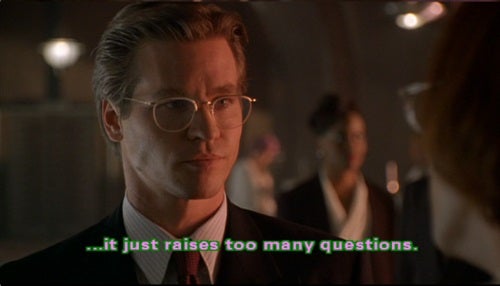The film has been marketed as an origin film, but it's only part true. It's really just the first twenty minutes of the film, telling Diana's story prior to "Justice League: War" before jumping to the present day set after the previous Superman two-parter. The first ten minutes go through the basics: Steve crashes on Themyscera and is saved by Diana, who goes with him to help man's world against her mother's wishes. The next ten minutes though show Steve introducing Diana to Greek archaeologist Julia Kapatelis; the two work together to share each other's cultures, so Diana can learn about the modern world while she can give Julia new insights on Greek customs. Diana also meets Julia's daughter Vanessa, who she finds a spiritual connection with, particularly their mother issues. Julia is shown to be more focused on her work than her daughter, much like Hippolyta appeared more dutiful as the queen than a mother. While Diana and Hippolyta are later able to reconcile, the same cannot be said for Julia and Vanessa. Without spoiling too much as to why, Julia is written in a way that makes her very unlikable, at least to me.
Rosario Dawson returns as to voice Wonder Woman from the previous DCAMU films and leads a mostly stellar voice cast. Much like how the Superman two-parter delved into the character's supporting cast within this universe, the same is said for Wonder Woman's. Steve Trevor makes his first appearance in these films since "Throne of Atlantis" while we're also introduced to Etta Candy, Ferdinand, and a good collection of Diana's rogues gallery, including Giganta, Doctors Cyber and Poison, and Medusa. Vanessa also becomes the villain Silver Swan, and while her character is written well, there are moments where the actress playing her sounds off, like her voice broke at times but they didn't want to go back and fix it.
With this film, I realized there's been some parallels between the DCAMU films this year, including the Superman two-parter and "Batman: Hush." As mentioned, Wonder Woman's corner of the universe is more fleshed out like Superman's was. And since the two broke up, Diana's relationship with Steve finally blossoms as Clark and Lois' did. In addition, Wonder Woman also shifts to a new costume that resembles her classic/modern iteration and the live action suit. Between the romance and costume changes for the characters, this is what I would call the Rebirth effect, where the current state of comics have impact on the animated films. The same can be said for Batman to a lesser degree, but that was more about adapting the "Hush" storyline, plus the fact Bruce and Selina broke up at the end. So two out of three isn't too bad on the romance column. Of the three stories though, Superman's was my favorite.
While this film is set within the DCAMU, those following the series will notice a significant change in animation. The character designs seem the same, but the style in animation seems to have gone for a more western approach compared to the anime influence we've seen before. I'm not sure if it was a budgetary issue considering DC has put out four films this year compared to the usual three or if this is going to be the new norm. I'll guess we'll know for sure when "Apokolips War" hits next year.
Nevertheless, the animation style doesn't hinder the fight scenes. They're all entertaining, particularly in how Wonder Woman is able to win. While some of it comes down to strength, we also get to see Diana's ingenuity and strategy at play. She's able to contend with Cheetah's speed by putting her in a more enclosed environment and later blinds herself to combat Medusa's stone-turning gaze. Said final battle with Medusa is my favorite of the film. We see Wonder Woman taking a major beating, from being thrown around and being bitten by the snakes in Medusa's hair, but she never shows any sign of giving up. In general, that's one of the best things the film gets right about Diana: she'll fight an enemy to the end and she won't turn away from friends who lost their way.
One problem I had with this film was the depiction of the amazons. Between this and the live action film, that one did a better job. For one, Hippolyta was shown from the beginning to be a caring mother as well as a inspiring leader. Also, the live action film did a good job at showing the amazons' fighting ability, even against those with advance weaponry like the German soldiers and their guns. Here, they all get jobbed by Medusa.
Overall, "Wonder Woman: Bloodlines" is a mostly satisfying film that's a faithful depiction of the Spirit of Truth with some enjoyable characters and great fight scenes. There isn't much more to it than that, but it should be enough for some.


